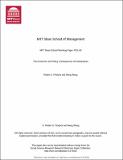| dc.contributor.author | Pindyck, Robert S. | |
| dc.contributor.author | Wang, Neng | |
| dc.date.accessioned | 2011-10-21T20:22:49Z | |
| dc.date.available | 2011-10-21T20:22:49Z | |
| dc.date.issued | 2009-09 | |
| dc.identifier.uri | http://hdl.handle.net/1721.1/66538 | |
| dc.description.abstract | What is the likelihood that the U.S. will experience a devastating catastrophic event over the next few decades – something that would substantially reduce the capital stock, GDP and wealth? What does the possibility of such an event imply for the behavior of economic variables such as investment, interest rates, and equity prices? And how much should society be willing to pay to reduce the probability or likely impact of such an event? We address these questions using a general equilibrium model that describes production, capital accumulation, and household preferences, and includes as an integral part the possible arrival of catastrophic shocks. Calibrating the model to average values of economic and financial variables yields estimates of the implied expected mean arrival rate and impact distribution of catastrophic shocks. We also use the model to calculate the tax on consumption society would accept to reduce the probability or impact of a shock. | en_US |
| dc.language.iso | en_US | en_US |
| dc.publisher | Cambridge, MA; Alfred P. Sloan School of Management, Massachusetts Institute of Technology | en_US |
| dc.relation.ispartofseries | MIT Sloan School of Management Working Paper;4751-09 | |
| dc.subject | catastrophes | en_US |
| dc.subject | rare events | en_US |
| dc.subject | economic uncertainty | en_US |
| dc.subject | consumption tax | en_US |
| dc.subject | national security | en_US |
| dc.title | The Economic and Policy Consequences of Catastrophes | en_US |
| dc.type | Working Paper | en_US |
